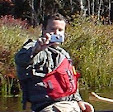In fact, the word "backyard" was accurate. People in the Blackstone River Valley had turned their backs to the river, literally. Homes and businesses faced away from the river, and trees and bushes blocked the view. There was a good reason for this. For decades textile mills dumped toxic dyes and chemicals into the many rivers running through the Blackstone Valley. People kept away from the foul smelling foam that blew off the river into the streets, they did not want to see the strange orange and green colored water that swirled behind their homes.
Since the 1980's thanks to the efforts of local towns, wastewater treatment plants, and the National Park Service, Blackstone Valley rivers were much cleaner. Beaver, coyotes, and deer returned to the river banks, fish swam downstream once again. As we paddled along enjoying the beauty, we wondered what it would take to get people to return to the water in boats.
I did some research and discovered to my surprise that from about 1920 and through the 1940s, there had been several "Canoe Clubs" in both the Massachusetts and Rhode Island sections of the Blackstone River Valley. One evening along the Ten Mile River, I met with some elderly residents. Back in their twenties, they had once been members of a "Canoe Club." They told me that paddling on the less polluted rivers and ponds in the Blackstone Valley was very popular before World War Two. After the war, they told me once people had cars, they wanted to travel to faraway places to paddle and camp. And so the Canoe Clubs slowly died away.
My hunch was that locals would return to the river to paddle after work if the whole process of getting on and off the river was made easy, safe and fun. So in 1999, I pitched my idea to the one surviving paddle club in Rhode Island, RICKA, the Rhode Island Canoe and Kayak Association.
I told the RICKA members that if they could provide experienced people to provide on the water leadership, and take this new canoe club under their administrative wing as a junior member, I could get the National Park Service to handle all the other logistics. The RICKA folks kindly agreed.
At the time I was working as a park ranger for the Blackstone River Valley National Heritage Corridor, part of the National Park Service. My supervisor and my ranger co-workers agreed to partner with me on this project twice a week. My most valuable helper was Suzanne Buchanan, the park's volunteer coordinator. She wisely suggested we name the group the Blackstone Valley Paddle Club, since people these days were paddling canoes and kayaks. Suzanne found seven volunteers, experienced paddlers to act as team leaders, to paddle beside the boats of inexperienced people so that they would feel safe as they learned a new skill.
Best of all the Heritage Corridor Commission granted us money for free boats. I contracted with local canoe and kayak companies to bring six free boats to each paddle location. People without boats signed up in advance for the free boats each week. The plan was beginning to gel. The Heritage Corridor Commission understood my end goal for the paddle club. The more local people who rediscovered the beauty of their backyard rivers, the more they would want to protect them from harm.
Each week I served as the logistics guy, making sure that for locals the entire experience was an enjoyable after-work experience. As a group, at the beginning of the season, we would vote on locations to paddle. I sent out detailed instructions to everyone who signed up for the trip. In the days before GPS I sent out emails with instructions like "take a right down the dirt road next to the red house and park beside the huge sycamore tree."
A vehicle shuttle plan made sure that there was transportation back to the starting point after each trip. When people arrived, RICKA trip leaders, our volunteer team leaders, and park rangers helped everyone unload boats and get safely on the river. Rangers gave a safety talk, team leaders briefly told people about the wildlife they could expect to see and the results of the most recent water quality tests on that stretch of river. Then we would all enjoy a leisurely evening paddle. Some evenings, sixty people would join us.
The Blackstone River could accommodate us all with ease. Twenty-three years later, the Blackstone Valley Paddle Club continues to paddle the rivers of the Blackstone Valley on summer evenings. Just like in the days of the Canoe Clubs, there are now community organizations with boat houses near the river. Paddling has returned to the Blackstone River Valley.
The Blackstone River could accommodate us all with ease. Twenty-three years later, the Blackstone Valley Paddle Club continues to paddle the rivers of the Blackstone Valley on summer evenings. Just like in the days of the Canoe Clubs, there are now community organizations with boat houses near the river. Paddling has returned to the Blackstone River Valley.




No comments:
Post a Comment
Note: Only a member of this blog may post a comment.